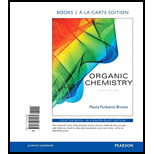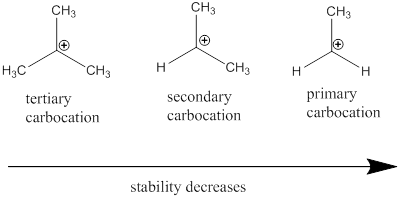
Concept explainers
(a)
Interpretation:
The differences between the first step in reactions of
Concept introduction:
Addition Reaction: It is defined as
In addition reaction of
Regioselective reaction: They are reactions which contain more than one product which are actually molecules with same molecular formula but different in the way they are connected and among those products only one product is major.
Markovnikov’s Addition Rule: The unsymmetrical alkene in a chemical compound reacts with hydrogen halide in a way, where halide ions attacks and bond to the more substitution position of carbon-carbon double bond.
Carbocation: it is carbon ion that bears a positive charge on it.
Leaving group: it is a fragment that leaves from a substrate with a pair of electrons via
Carbocation stability order:

(b)
Interpretation:
The product and reason for attack of
Concept introduction:
Addition Reaction: It is defined as chemical reaction in which two given molecules combines and forms product. The types of addition reactions are electrophilic addition, nucleophilic addition, free radical additions and cycloadditions. Generally, compounds with carbon-hetero atom bonds favors addition reaction.
In addition reaction of alkenes when two substituents are placed on same side of
Regioselective reaction: They are reactions which contain more than one product which are actually molecules with same molecular formula but different in the way they are connected and among those products only one product is major.
Markovnikov’s Addition Rule: The unsymmetrical alkene in a chemical compound reacts with hydrogen halide in a way, where halide ions attacks and bond to the more substitution position of carbon-carbon double bond.
Trending nowThis is a popular solution!

Chapter 6 Solutions
Organic Chemistry, Books a la Carte Edition (8th Edition)
- 2-Methyl-2-butene reacts with HBr in the presence of peroxide to give a. a secondary alkyl bromide. b. a primary alkyl bromide. c. a tertiary alkyl bromide. d. a vicinal dibromide.arrow_forward4. Draw the structure and name the first ten (10) members of Acid Halides using bromine as the halide.arrow_forward5. Consider the reaction below and answer the following questions + OH + H₂O a. Draw in ALL missing lone pair electrons as well as electron movement arrows on the reactant side Identify the nucleophile and electrophile on the reactant side b. c. Identify which side of the equilibrium will dominate. d. Draw resonance structures for the organic compound on the product side CHEM 241-Group05. Ormord d ****arrow_forward
- 7. The reaction of methoxide anion with bromoethane to yield the ether ethyl methyl ether and the bromide anon (Br-) is an excellent example of a general reaction type called Sy2 (substitution nucleophilic bimolecular): CH,0+ CH,СH-Br a CH3-0-CH,СH; + Br- a. Change in enthalpy is -103 kJ/mol; the change in entropy is + 0.025 kJ/mol-K. Calculate DG at 300K. b. Is the reaction endergonic or exergonic? c. Is the reaction endothermic or exothermic? d. Use curved arrows to show the complete mechanism. Reaction of 2-methyl-1-butene with H-Cl could yield TWO alkyl chloride products. Draw and name 8. them.arrow_forwardIII. What is the product for no 2.arrow_forwardIs this reaction a feasible method of removing SO2? Why or why not?arrow_forward
- Determine the product of the reaction considering the conditions given. A. No product will be formed B. 2-methoxy-2,3,3-trimethylpentane C. 2,3,3-trimethyl-1-pentanearrow_forwardDraw the organic product you would expect to isolate from the nucleophilic substitution reaction between the molecules shown. Note: You do not need to draw any of the side products of the reaction, only the substitution product. H × 5 Br + HO + 1 Click and drag to start drawing a structure.arrow_forwardB) 21. What is a major product of the conjugate addition reaction shown in the box? 1. Base 130 (= neutralization) Ph CO,Et 1305 130 4d.arrow_forward
- 1. What is the bond angle in carbon tetrachloride? 2. What is the product of the reaction of pent-2-ene with Cl2? 3.Which statement is correct? * A. The bond length increases when the difference between the electronegativity of the atoms is higher B. The bond length increases when the number when there is an increase in pi bonds. C. Increasing the bond polarity increases the bond length. D. Sp2 has shorter bond length that sp. 4. How many moles of O2 gas is theoretically needed for 1 mole of hexane? 5. What is the MOST LIKELY product of the reaction of pent-1-ene with HCL? 6. Which one creates a sigma bond? * A. 2 pz atomic orbitals B. 2 py atomic orbitals C. 2 px atomic orbitals D. none of these 7.How many hydrogen atoms are there in trans-1-bromo-2-methylcyclohexane? 8.arrow_forwardExplain why methyl alcohol reacts with HBr faster than other primary alcohols?arrow_forward1. Give balanced chemical equations for the following reactions: a. the oxidation of ethanol (two stages – use [O] in your equation but give name of the oxidising agent used in the reaction and any colour change you would see. b. the oxidation of propan-2-ol c. the dehydration of propan-2-ol d. the reaction of butylamine and hydrochloric acid (what type of reaction is this?)arrow_forward

 EBK A SMALL SCALE APPROACH TO ORGANIC LChemistryISBN:9781305446021Author:LampmanPublisher:CENGAGE LEARNING - CONSIGNMENT
EBK A SMALL SCALE APPROACH TO ORGANIC LChemistryISBN:9781305446021Author:LampmanPublisher:CENGAGE LEARNING - CONSIGNMENT

